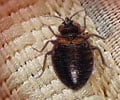Entomopathogenic fungi may be a safe and efficient means of controlling Triatoma infestans, the bug that helps spread Chagas disease, according to new research conducted in Argentina.
Entomopathogenic fungi may be a safe and efficient means of controlling Triatoma infestans, the bug that helps spread Chagas disease, according to new research conducted in Argentina. The study, published May 12 in the open-access journal PLoS Neglected Tropical Diseases, shows the success of the fungi to kill bugs resistant to current control methods.
Chagas disease is the most relevant parasitic disease in Latin America, being a major burden that affects mostly poor human populations living in rural areas.The parasite Trypanosoma cruzi is mainly transmitted through blood-feeding triatomine bugs; in the southern Cone of South America the most prominent vector is Triatoma infestans. Current control strategies based on residual chemical insecticide application are threatened by the emergence of pyrethroid resistance.
The researchers, led by Patricia Juárez, performed both laboratory and field experiments showing that the entomopathogenic fungus Beauveria bassiana is virulent against bug populations from pyrethroid-resistant foci in the Argentina/Bolivia border.
An attraction-infection trap was developed and tested during a 15-day period in field assays performed in two rural villages, demonstrating that more than 50% of the bugs detected were killed by fungal infection. By existing vector population models, the bug population reduction was estimated to reduce the risk of acquiring the parasite infection.
This approach might also prove useful at different settings, e.g. peridomiciliary environments where current tactics and procedures are reported to fail, and rural communities located in remote areas inaccessible to sanitary control teams.
The authors emphasize that these results might help to provide a safe and efficient alternative to overcome bug pyrethroid-resilience in the short term, and might be useful to control other Chagas disease vectors as well.
Advertisement
LIN












